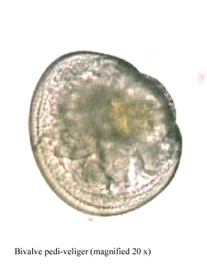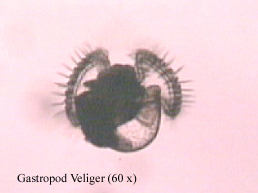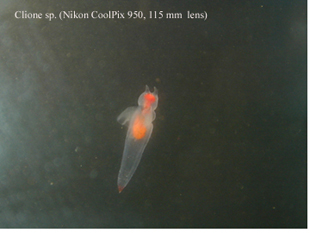Invertebrates
in the Plankton: Mollusca
The molluscs, including
gastropods, bivalves, cephalopods, and chitons, are the second largest
of all invertebrate groups. As adults, these animals have varied
lifestyles, living in the water column, on rocky and sandy bottoms, within
tidal flats and on rocky shores. We observed several planktonic molluscs,
described below. For more information about the habitats of adult
molluscs, see the other habitat pages.
 This
pedi-veliger larva is practially a juvenile clam. Notice its
well-developed shell. Floating in the plankton, this animal consumes
microscopic algae. It will soon settle and grow to be a benthic adult.
In early stages of its development, this animal resembled the gastropod
veliger below.
This
pedi-veliger larva is practially a juvenile clam. Notice its
well-developed shell. Floating in the plankton, this animal consumes
microscopic algae. It will soon settle and grow to be a benthic adult.
In early stages of its development, this animal resembled the gastropod
veliger below.
 The
Lacuna veliger swims freely in the plankton, using large
ciliated lobes for locomotion and food capture. At metamorphosis,
the gastropod's body form changes dramatically. The cilated lobes,
larval heart, and part of the larval excretory system are lost when the
animal assumes its bethic adult form.
The
Lacuna veliger swims freely in the plankton, using large
ciliated lobes for locomotion and food capture. At metamorphosis,
the gastropod's body form changes dramatically. The cilated lobes,
larval heart, and part of the larval excretory system are lost when the
animal assumes its bethic adult form.
 Clione
limacina, known commonly as a "sea butterfly," was one of the few completely
pelagic adult gastropods we encountered in the plankton.
This pteropod, as it is classified taxonomically, is quite cosmopolitan
in its distribution, ranging throughout the northern oceans. Clione
are relatively rare finds around Friday Harbor, though they are common
to the north, in the Strait of Georgia. The species has a planktonic
veliger larva and a fascinating undulating swimming pattern.
To see the clione swim, check out this movie.
Clione also has an unusual reproductive appendage that can extend out from
the body and wrap around its partner. This keeps the organisms linked
together in the water current.
Clione
limacina, known commonly as a "sea butterfly," was one of the few completely
pelagic adult gastropods we encountered in the plankton.
This pteropod, as it is classified taxonomically, is quite cosmopolitan
in its distribution, ranging throughout the northern oceans. Clione
are relatively rare finds around Friday Harbor, though they are common
to the north, in the Strait of Georgia. The species has a planktonic
veliger larva and a fascinating undulating swimming pattern.
To see the clione swim, check out this movie.
Clione also has an unusual reproductive appendage that can extend out from
the body and wrap around its partner. This keeps the organisms linked
together in the water current.
Plankton
Home Annelida
Arthropoda
Chaetognatha
Chordata
Cnidaria & Ctenophora
Echinodermata
Invertebrates
2000
 This
pedi-veliger larva is practially a juvenile clam. Notice its
well-developed shell. Floating in the plankton, this animal consumes
microscopic algae. It will soon settle and grow to be a benthic adult.
In early stages of its development, this animal resembled the gastropod
veliger below.
This
pedi-veliger larva is practially a juvenile clam. Notice its
well-developed shell. Floating in the plankton, this animal consumes
microscopic algae. It will soon settle and grow to be a benthic adult.
In early stages of its development, this animal resembled the gastropod
veliger below.
 The
Lacuna veliger swims freely in the plankton, using large
ciliated lobes for locomotion and food capture. At metamorphosis,
the gastropod's body form changes dramatically. The cilated lobes,
larval heart, and part of the larval excretory system are lost when the
animal assumes its bethic adult form.
The
Lacuna veliger swims freely in the plankton, using large
ciliated lobes for locomotion and food capture. At metamorphosis,
the gastropod's body form changes dramatically. The cilated lobes,
larval heart, and part of the larval excretory system are lost when the
animal assumes its bethic adult form.
 Clione
limacina, known commonly as a "sea butterfly," was one of the few completely
pelagic adult gastropods we encountered in the plankton.
This pteropod, as it is classified taxonomically, is quite cosmopolitan
in its distribution, ranging throughout the northern oceans. Clione
are relatively rare finds around Friday Harbor, though they are common
to the north, in the Strait of Georgia. The species has a planktonic
veliger larva and a fascinating undulating swimming pattern.
To see the clione swim, check out this
Clione
limacina, known commonly as a "sea butterfly," was one of the few completely
pelagic adult gastropods we encountered in the plankton.
This pteropod, as it is classified taxonomically, is quite cosmopolitan
in its distribution, ranging throughout the northern oceans. Clione
are relatively rare finds around Friday Harbor, though they are common
to the north, in the Strait of Georgia. The species has a planktonic
veliger larva and a fascinating undulating swimming pattern.
To see the clione swim, check out this